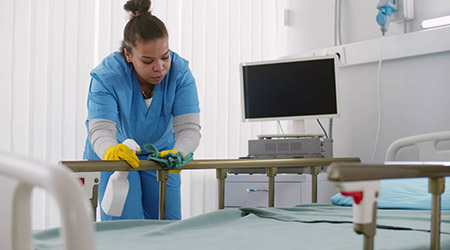A large midwestern hospital, with approximately 700 licensed beds and over 1.2 million patient encounters yearly, purchased several hundred state-of-the-art, non-invasive medical device monitoring systems. Within two years, there was visible damage to the monitoring systems, due to chemical exposure during the disinfection process.
Surface disinfectant compatibility is not a new issue to the healthcare industry. The goal of a recent case study was to find the problem’s root causes through deep dive real-world analysis.
Through the deep dive analysis and testing performed, it became evident that the root cause of the damage was chemical exposure to components by the hospital’s use of disinfectants known to cause damage. Additionally, there was a complex combination of challenges and gaps, including a lack of understanding about infection prevention products and guidelines used within the hospital by the medical device company and breakdowns in communication within each organization and between both parties. These problems created potential risks to patients and high costs for both the hospital and the medical device company, which could have been avoided.
Another root cause of the problem occurred during the design phase of the monitoring device. Without guidelines or minimum testing standards of all categories of EPA-registered hospital grade disinfectants, the medical company was left to determine which cleaning agents to test for cleanability and compatibility between surface materials and disinfectants when designing their product. As we found in this case study, the hospital’s Infection Prevention & Control (IP&C) guidelines to prevent patient risk were not compatible with the only validated cleaning method prescribed by the medical device manufacturer.
Surface disinfection compatibility challenges came to the forefront of the hospital’s awareness through the discovery and analysis of damage to the monitoring devices. This case study is an example of how these challenges create risks to patient safety and present significant liability for both the healthcare facility and the manufacturer when not addressed. Due to the complexity of this problem, many facilities pay high costs for repair, replacement, and ongoing maintenance and in many cases the problem is virtually overlooked.
“Surface disinfection incompatibility creates risks and costs the healthcare industry millions of dollars annually,” says Barbara Strain, MA, SM(ASCP), CVAHP, the Board Strategic Liaison for AHVAP. “It is important to align the decision-making process for onboarding medical devices with a risk mitigation mentality that addresses patients, staff, devices, and environment. If there is not a balanced approach, then the failure of one may cause all four to fail.”
HSI and AHVAP collaborated on developing this case study.
Linda Lybert, the Executive Director of the Healthcare Surfaces Institute, found that “there is confusion, conflicting recommendations, and no minimum required testing and no validation standards to ensure surface materials can be effectively cleaned and disinfected. This case study provides insight into the many gaps that exist and what we must address.”
he full case study can be found at healthcaresurfacesinstitute.org or AHVAP.org.

 Designing Healthcare Facilities for Pediatric and Geriatric Populations
Designing Healthcare Facilities for Pediatric and Geriatric Populations Kaiser Permanente Announces New Hospital Tower at Sunnyside Medical Center
Kaiser Permanente Announces New Hospital Tower at Sunnyside Medical Center Building Disaster Resilience Through Collaboration
Building Disaster Resilience Through Collaboration Amae Health Expands to New York City
Amae Health Expands to New York City Hospital for Special Surgery Opens Two New Facilities in New Jersey
Hospital for Special Surgery Opens Two New Facilities in New Jersey